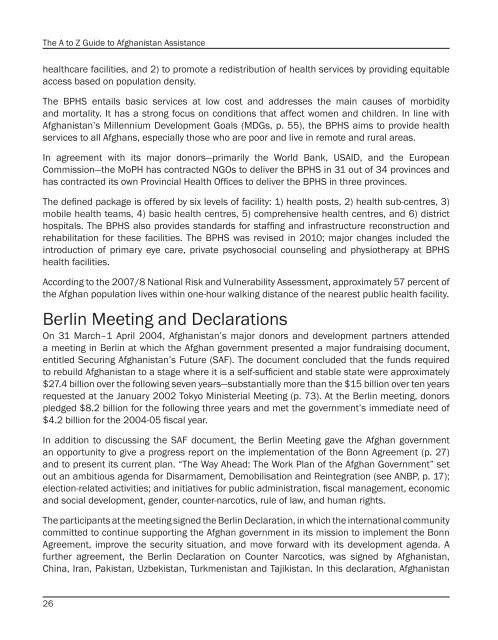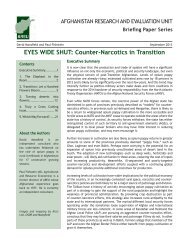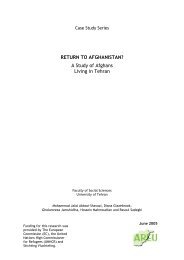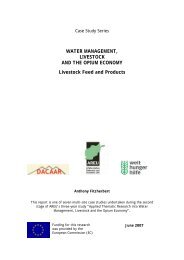A to Z Guide to Afghanistan Assistance 2012 - the Afghanistan ...
A to Z Guide to Afghanistan Assistance 2012 - the Afghanistan ...
A to Z Guide to Afghanistan Assistance 2012 - the Afghanistan ...
Create successful ePaper yourself
Turn your PDF publications into a flip-book with our unique Google optimized e-Paper software.
The A <strong>to</strong> Z <strong>Guide</strong> <strong>to</strong> <strong>Afghanistan</strong> <strong>Assistance</strong><br />
healthcare facilities, and 2) <strong>to</strong> promote a redistribution of health services by providing equitable<br />
access based on population density.<br />
The BPHS entails basic services at low cost and addresses <strong>the</strong> main causes of morbidity<br />
and mortality. It has a strong focus on conditions that affect women and children. In line with<br />
<strong>Afghanistan</strong>’s Millennium Development Goals (MDGs, p. 55), <strong>the</strong> BPHS aims <strong>to</strong> provide health<br />
services <strong>to</strong> all Afghans, especially those who are poor and live in remote and rural areas.<br />
In agreement with its major donors—primarily <strong>the</strong> World Bank, USAID, and <strong>the</strong> European<br />
Commission—<strong>the</strong> MoPH has contracted NGOs <strong>to</strong> deliver <strong>the</strong> BPHS in 31 out of 34 provinces and<br />
has contracted its own Provincial Health Offices <strong>to</strong> deliver <strong>the</strong> BPHS in three provinces.<br />
The defined package is offered by six levels of facility: 1) health posts, 2) health sub-centres, 3)<br />
mobile health teams, 4) basic health centres, 5) comprehensive health centres, and 6) district<br />
hospitals. The BPHS also provides standards for staffing and infrastructure reconstruction and<br />
rehabilitation for <strong>the</strong>se facilities. The BPHS was revised in 2010; major changes included <strong>the</strong><br />
introduction of primary eye care, private psychosocial counseling and physio<strong>the</strong>rapy at BPHS<br />
health facilities.<br />
According <strong>to</strong> <strong>the</strong> 2007/8 National Risk and Vulnerability Assessment, approximately 57 percent of<br />
<strong>the</strong> Afghan population lives within one-hour walking distance of <strong>the</strong> nearest public health facility.<br />
Berlin Meeting and Declarations<br />
On 31 March–1 April 2004, <strong>Afghanistan</strong>’s major donors and development partners attended<br />
a meeting in Berlin at which <strong>the</strong> Afghan government presented a major fundraising document,<br />
entitled Securing <strong>Afghanistan</strong>’s Future (SAF). The document concluded that <strong>the</strong> funds required<br />
<strong>to</strong> rebuild <strong>Afghanistan</strong> <strong>to</strong> a stage where it is a self-sufficient and stable state were approximately<br />
$27.4 billion over <strong>the</strong> following seven years—substantially more than <strong>the</strong> $15 billion over ten years<br />
requested at <strong>the</strong> January 2002 Tokyo Ministerial Meeting (p. 73). At <strong>the</strong> Berlin meeting, donors<br />
pledged $8.2 billion for <strong>the</strong> following three years and met <strong>the</strong> government’s immediate need of<br />
$4.2 billion for <strong>the</strong> 2004-05 fiscal year.<br />
In addition <strong>to</strong> discussing <strong>the</strong> SAF document, <strong>the</strong> Berlin Meeting gave <strong>the</strong> Afghan government<br />
an opportunity <strong>to</strong> give a progress report on <strong>the</strong> implementation of <strong>the</strong> Bonn Agreement (p. 27)<br />
and <strong>to</strong> present its current plan. “The Way Ahead: The Work Plan of <strong>the</strong> Afghan Government” set<br />
out an ambitious agenda for Disarmament, Demobilisation and Reintegration (see ANBP, p. 17);<br />
election-related activities; and initiatives for public administration, fiscal management, economic<br />
and social development, gender, counter-narcotics, rule of law, and human rights.<br />
The participants at <strong>the</strong> meeting signed <strong>the</strong> Berlin Declaration, in which <strong>the</strong> international community<br />
committed <strong>to</strong> continue supporting <strong>the</strong> Afghan government in its mission <strong>to</strong> implement <strong>the</strong> Bonn<br />
Agreement, improve <strong>the</strong> security situation, and move forward with its development agenda. A<br />
fur<strong>the</strong>r agreement, <strong>the</strong> Berlin Declaration on Counter Narcotics, was signed by <strong>Afghanistan</strong>,<br />
China, Iran, Pakistan, Uzbekistan, Turkmenistan and Tajikistan. In this declaration, <strong>Afghanistan</strong><br />
26

















